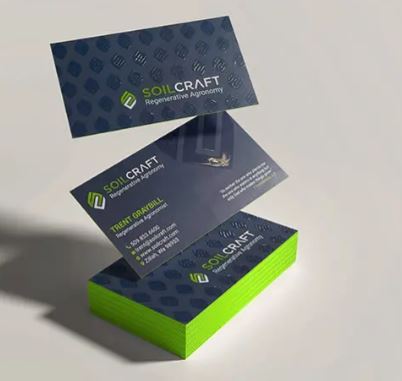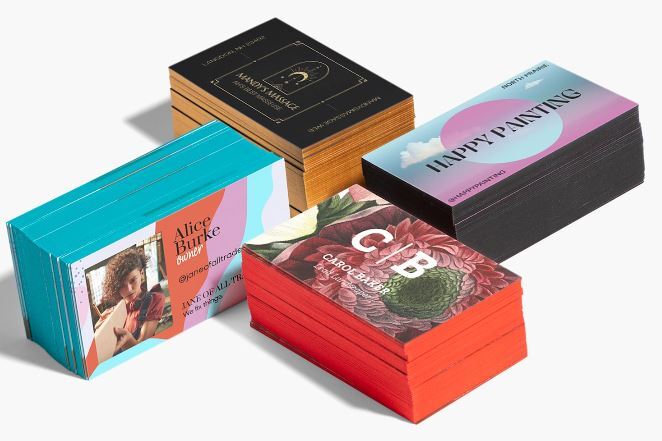AHSAN QAIME
Painted edge business cards are a popular choice for professionals looking to make a bold and lasting impression with their branding. These cards stand out from standard business cards thanks to the vibrant colors applied to the edges, giving them a unique and premium look. Whether you are a designer, entrepreneur, or a creative professional, painted edge business cards offer a simple yet effective way to elevate your business's image. In this article, we will explore why these cards are so effective, their features, customization options, and tips on designing the perfect card to ensure that your business stands out

What Are Painted Edge Business Cards?
Painted edge business cards are premium business cards with a distinctive feature: the edges of
the card are coated with a vibrant color, making them visually striking. The edges of these cards
are often painted with a solid or metallic ink in various colors, offering a beautiful contrast to the
rest of the card’s design. This small but impactful detail makes a big difference in how your card
is perceived, making it more memorable and setting it apart from ordinary business cards.
Painted edge business cards are typically thicker than standard cards, usually made from 32pt or
thicker cardstock. This thickness not only enhances the overall durability of the card but also
contributes to a high-end, premium feel. When a card is thicker and has color around the edges, it
instantly exudes a sense of luxury and attention to detail that catches the eye
Why Choose Painted Edge Business Cards?
There are several reasons why painted edge business cards have become a top choice for those
looking to elevate their brand’s image. Below are a few key advantages:
1. Aesthetic Appeal
The painted edges of these visiting cards give them a modern and stylish look, making them
more eye-catching than standard cards. Whether you choose bright and bold colors or more
subtle hues, the colored edges add a unique flair that ensures your card stands out from the
crowd. It adds a dimension to the card that simply cannot be achieved with a standard design
2. Premium Feel
The thickness and quality of the material used for painted edge business cards contribute to a
luxurious feel. A thicker card instantly communicates quality, and when paired with painted
edges, it sends a message that your business cares about attention to detail and professionalism.
The extra thickness also makes the card more durable, ensuring that it won’t easily bend or tear.
3. Customization Options
Painted edge business cards are highly customizable, allowing you to choose the card’s edge
color, finish, size, and paper type. This means that your business cards can be tailored to reflect
your brand’s identity and personality. Whether you want something bold, elegant, or minimalist,
painted edge cards can be designed to fit any aesthetic or message you want to convey and you
have full liberty to review your cards design and looks.
4. Memorability
The primary purpose of a business card is to leave a lasting impression, and painted edge
business cards achieve this effortlessly. The boldness of the painted edges means that the card is
more likely to be remembered, even after it’s been placed in a wallet or business card holder.
When people see these cards, they are more likely to comment on them, leading to a
conversation about your business.

5. Professionalism
While painted edges add a creative and artistic touch, they also project an image of
professionalism and refinement. These cards are especially popular among creative professionals
such as designers, photographers, and boutique owners who want their business cards to reflect
their artistic capabilities. The quality of the cards suggests that your business is serious, and you
value making a good impression.
Types of Painted Edge Colors
One of the most exciting features of painted edge business cards is the wide range of color
options available. Depending on your brand’s color palette and your personal preferences, you
can choose from an array of vibrant, neutral, or even metallic colors to create a unique look
Standard Edge Colors
- Charcoal Black
- Red
- Yellow
- Blue
- Orange
- Purple
- Pink
- Turquoise
- Brown
Each of these colors can add an extra dimension to your business card, helping it to match your
brand or make a bold statement.
Pearlescent Edge Colors
If you want something a little more refined and sophisticated, pearlescent edge colors are a great
option. These colors feature a subtle sheen that can add an elegant touch to your cards. Some
popular pearlescent colors include:
- Pearlescent Gold
- Pearlescent Green
- Pearlescent Blue
- Pearlescent
- Pearlescent Yellow
- Pearlescent Orange
These pearlescent colors create a luxurious and refined feel while still offering the visual impact
that painted edge cards are known for.
Stamped Foil Colors
For an added layer of sophistication, you can opt for stamped foil colors. This technique uses
metallic foil to add a shiny, reflective layer to the edges of your business cards, creating a bold,
eye-catching look. Foil options include:
- Gold
- Silver
- Copper
- Red
- Blue
- Green
Stamped foil adds an extra touch of elegance and can be used to highlight particular elements of
your design, such as your logo or contact information
Customization and Design Tips
The customization options for painted edge business cards are almost limitless, but to make the
most out of your design, there are a few key factors to consider:
1. Choose the Right Edge Color
When selecting your edge color, ensure it complements your overall branding and design. You
want the color of the edges to enhance your card without overpowering your logo or contact
details. For example, if your brand has a bright color palette, you might want to choose a bold
edge color to match, like vibrant blue or red. On the other hand, if your brand is more
understated, a classic black or metallic gold might work best
2. Avoid Using Borders
While it’s tempting to include a border in your design, it’s generally not recommended for
painted edge business cards. The printing process can sometimes cause slight shifts in the
artwork, leading to uneven borders. It’s better to design without borders or ensure they are far
enough away from the edges to prevent distortion during printing.
3. Use High-Quality Images and Graphics
Since painted edge business cards are typically thicker and made from premium paper stock, the
quality of the images and graphics you use will be more noticeable. Make sure your artwork is
high resolution and optimized for print to ensure that your cards look sharp and professional
4. Consider the Finishing Touches
You can add a finishing touch to your painted edge cards to further enhance their appeal.
Consider adding a gloss, matte, or soft-touch lamination to the card’s surface for a sleek, smooth
finish. A gloss lamination adds shine and vibrancy, while a matte lamination provides a more
sophisticated, subtle look. Soft-touch lamination adds a velvety texture that enhances the tactile
feel of the card.
5. Keep the Design Simple
While it’s tempting to go all out with your design, it’s often best to keep it simple when working
with painted edge business cards. The edges are the main feature, so you want the design to
complement, not compete with, them. A clean, minimalist design will help highlight the edges
and ensure that your contact information is easy to read
How Painted Edge Business Cards Are Made?
The process of making painted edge business cards involves several intricate steps to ensure that
the edges are coated properly and the design is executed flawlessly. Here’s a general overview of
how these cards is made:
- Printing the Card Design: The first step is to print your business card design on high-
quality cardstock using digital or offset printing. This can include full-color printing on
the front and back of the card. - Coloring the Edges: After the card is printed, the edges are carefully painted using a
process that involves spraying layers of ink onto the edges. The ink is sprayed multiple
times to achieve the desired depth of color - Finishing: Once the edges are painted, the cards are left to dry, and additional finishes
such as laminating or foiling can be applied to further enhance the design - Cutting the Cards: The cards are then cut to their final shape, whether that’s a standard
rectangle or a custom shape with rounded corners - Quality Control: After the cards are printed, cut, and finished, they go through a quality
control process to ensure that each card is up to standard.
